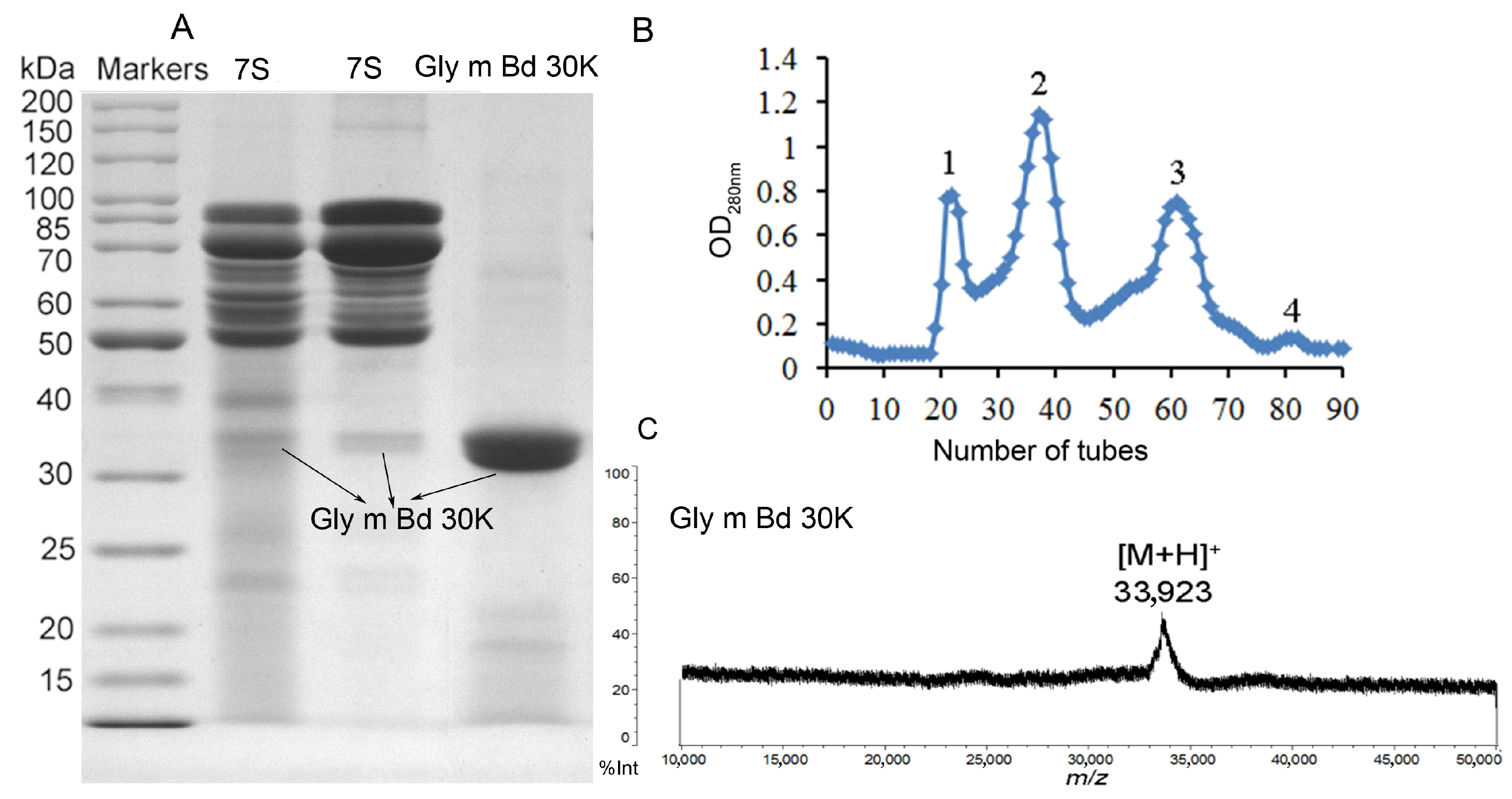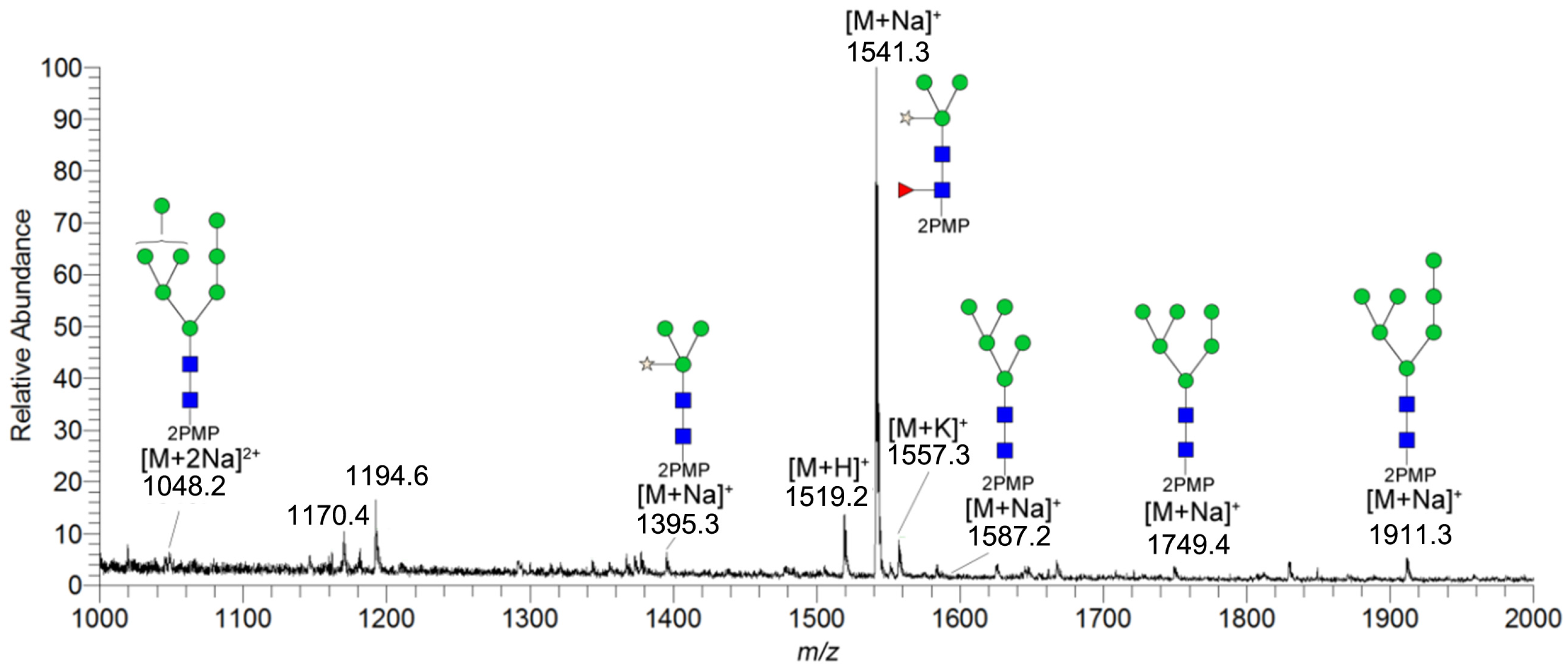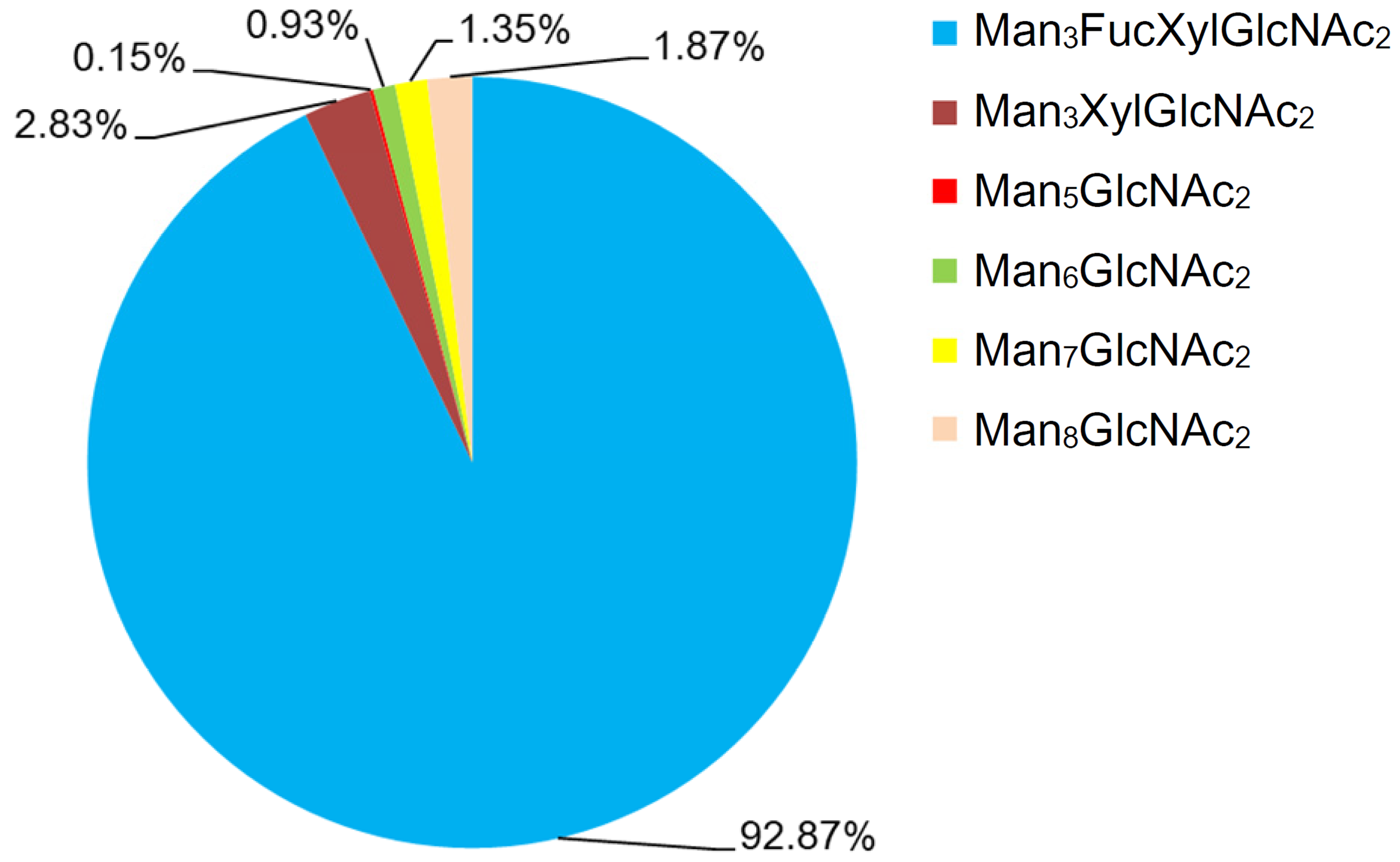Mass Spectrometric Analysis of Antigenic Determinant Glycans of Soybean Glycoprotein Gly m Bd 30K
Abstract
1. Introduction
2. Results and Discussion
2.1. Isolation, Purification, and Identification of Gly m Bd 30K
2.2. ESI-MS and MS/MS Analysis of Gly m Bd 30K Glycans
2.3. Separation and Quantitative Analysis of Gly m Bd 30K N-Glycans by Online HILIC-ESI-MS/MS
3. Materials and Methods
3.1. Reagents and Instruments
3.2. Packing of Chromatography Column
3.3. Isolation and Purification of Gly m Bd 30K
3.4. Identification of Gly m Bd 30K by SDS-PAGE
3.5. MALDI-TOF Analysis
3.6. Release of N-Glycans from 7S Globulin by PNGase F
3.7. Preparation of N-Glycans by One-Pot Method
3.8. Analysis by ESI-MS and MS/MS
3.9. Online HILIC-UV-MS/MS Analysis
4. Conclusions
Supplementary Materials
 , mannose;
, mannose;  , N-acetylglucosamine;
, N-acetylglucosamine;  , xylose; and
, xylose; and  , fucose. Figure S3: MS/MS analysis of N-glycans released from Gly Bd 30K;
, fucose. Figure S3: MS/MS analysis of N-glycans released from Gly Bd 30K;  , N-acetylglucosamine;
, N-acetylglucosamine;  , mannose;
, mannose;  , fucose; and
, fucose; and  , xylose.
, xylose.Author Contributions
Funding
Institutional Review Board Statement
Informed Consent Statement
Data Availability Statement
Conflicts of Interest
References
- Shevkani, K.; Chourasia, S. Dietary proteins: Functions, health benefits and healthy aging. In Nutrition, Food and Diet in Ageing and Longevity; Springer International Publishing: Cham, Switzerland, 2021; pp. 3–37. [Google Scholar]
- Astawan, M.; Prayudani, A.P.G. The overview of food technology to process soy protein isolate and its application toward food industry. World Nutr. J. 2020, 4, 12–17. [Google Scholar] [CrossRef]
- L’Hocine, L.; Boye, J.I. Allergenicity of soybean: New developments in identification of allergenic proteins, cross-reactivities and hypoallergenization technologies. Crit. Rev. Food Sci. Nutr. 2007, 47, 127–143. [Google Scholar] [CrossRef]
- Wang, T.; Qin, G.X.; Sun, Z.W.; Zhao, Y. Advances of research on glycinin and β-conglycinin: A review of two major soybean allergenic proteins. Crit. Rev. Food Sci. Nutr. 2014, 54, 850–862. [Google Scholar] [CrossRef] [PubMed]
- Bannon, G.A. What makes a food protein an allergen? Curr. Allergy Asthma Rep. 2004, 4, 43–46. [Google Scholar] [CrossRef] [PubMed]
- Wiederstein, M.; Baumgartner, S.; Lauter, K. Soybean (Glycine max) allergens—A review on an outstanding plant food with allergenic potential. ACS Food Sci. Technol. 2023, 3, 363–378. [Google Scholar] [CrossRef]
- Altmann, F. The role of protein glycosylation in allergy. Int. Arch. Allergy Immunol. 2007, 142, 99–115. [Google Scholar] [CrossRef]
- Hale, R.C.; Morais, D.; Chou, J.; Stowell, S.R. The role of glycosylation in clinical allergy and immunology. J. Allergy Clin. Immunol. 2024, 153, 55–66. [Google Scholar] [CrossRef]
- Finkina, E.I.; Danilova, Y.D.; Melnikova, D.N.; Ovchinnikova, T.V.; Bogdanov, I.V. Sensitization Potential of the Major Soybean Allergen Gly m 4 and Its Cross-Reactivity with the Birch Pollen Allergen Bet v 1. Int. J. Mol. Sci. 2025, 26, 2932. [Google Scholar] [CrossRef] [PubMed]
- Xu, Y.; Shi, J.; Wang, X.; Wang, Y.; Zhao, Y.; Raghavan, V.; Wang, J. Effects of ultrasound-assisted punicalagin binding on the allergenicity reduction of soybean protein 7S. Food Chem. 2025, 482, 144195. [Google Scholar] [CrossRef]
- Liew, C.Y.; Luo, H.S.; Chen, J.L.; Ni, C.K. High Abundance of Unusual High Mannose N-Glycans Found in Beans. ACS Omega 2024, 9, 45822–45827. [Google Scholar] [CrossRef] [PubMed]
- Li, C.; Tian, Y.; Han, J.; Lu, Y.; Zou, M.; Jia, Y.; Wang, C.; Huang, L.; Wang, Z. An innovative method used for the identification of N-glycans on soybean allergen β-conglycinin. Food Sci. Hum. Wellness 2023, 12, 842–850. [Google Scholar] [CrossRef]
- Helm, R.M.; Cockrell, G.; Herman, E.; Burks, A.W.; Sampson, H.A.; Bannon, G.A. Cellular and molecular characterization of a major soybean allergen. Int. Arch. Allergy Immunol. 1998, 117, 29–37. [Google Scholar] [CrossRef] [PubMed]
- Helm, R.M.; Cockrell, G.; Connaughton, C.; West, C.; Herman, E.; Sampson, H.A.; Bannon, G.A.; Burks, A. Mutational analysis of the IgE-binding epitopes of P34/Gly m Bd 30K. J. Allergy Clin. Immunol. 2000, 105, 378–384. [Google Scholar] [CrossRef] [PubMed]
- Ogawa, T.; Tsuji, H.; Bando, N.; Kitamura, K.; Zhu, Y.L.; Hirano, H.; Nishikawa, K. Identification of the Soybean Allergenic Protein, Gly m Bd 30K, with the Soybean Seed 34-kDa Oilbody-associated Protein. Biosci. Biotechnol. Biochem. 1993, 57, 1030–1033. [Google Scholar] [CrossRef] [PubMed]
- Ogawa, T.; Bando, N.; Tsuji, H.; Okajima, H.; Nishikawa, K.; Sasaoka, K. Investigation of the IgE-binding proteins in soybeans by immunoblotting with the sera of the soybean-sensitive patients with atopic dermatitis. J. Nutr. Sci. Vitaminol. 1991, 37, 555–565. [Google Scholar] [CrossRef]
- Homann, A.; Schramm, G.; Jappe, U. Glycans and glycan-specific IgE in clinical and molecular allergology: Sensitization, diagnostics, and clinical symptoms. J. Allergy Clin. Immunol. 2017, 140, 356–368. [Google Scholar] [CrossRef]
- Gomord, V.; Fitchette, A.; Menu-Bouaouiche, L.; Saint-Jore-Dupas, C.; Plasson, C.; Michaud, D.; Faye, L. Plant-specific glycosylation patterns in the context of therapeutic protein production. Plant Biotechnol. J. 2010, 8, 564–587. [Google Scholar] [CrossRef]
- Gyorgypal, A.; Banerjee, S.; Conroy, M.E.; Anthony, R.M. Glycobiology of IgE. Immunol. Rev. 2025, 331, e70032. [Google Scholar] [CrossRef]
- Plum, M.; Tjerrild, L.; Raiber, T.; Bantleon, F.; Bantleon, S.; Miehe, M.; Jabs, F.; Seismann, H.; Möbs, C.; Pfützner, W.; et al. Structural and functional analyses of antibodies specific for modified core N-glycans suggest a role in TH2 responses. Allergy 2023, 78, 121–130. [Google Scholar] [CrossRef]
- Lu, Y.; Sun, L.; Li, C.; Wang, X.; Li, W.; Zhao, T.; Huang, L.; Wang, Z. Comparative mass spectrometry analysis of N-glycans from the glycoproteins of eight allergy-inducing plants. Food Chem. 2022, 384, 132440. [Google Scholar] [CrossRef]
- Hemmer, W.; Altmann, F.; Holzweber, F.; Gruber, C.; Wantke, F.; Wöhrl, S. ImmunoCAP cellulose displays cross-reactive carbohydrate determinant (CCD) epitopes and can cause false-positive test results in patients with high anti-CCD IgE antibody levels. J. Allergy Clin. Immunol. 2018, 141, 372–381.e3. [Google Scholar] [CrossRef]
- Platts-Mills, T.A.; Hilger, C.; Jappe, U.; van Hage, M.; Gadermaier, G.; Spillner, E.; Lidholm, J.; Keshavarz, B.; Aalberse, R.C.; van Ree, R.; et al. Carbohydrate epitopes currently recognized as targets for IgE antibodies. Allergy 2021, 76, 2383–2394. [Google Scholar] [CrossRef]
- Herman, E.M.; Helm, R.M.; Jung, R.; Kinney, A.J. Genetic modification removes an immunodominant allergen from soybean. Plant Physiol. 2003, 132, 36–43. [Google Scholar] [CrossRef]
- Ogawa, T.; Samoto, M.; Takahashi, K. Soybean allergens and hypoallergenic soybean products. J. Nutr. Sci. Vitaminol. 2000, 46, 271–279. [Google Scholar] [CrossRef]
- Bando, N.; Tsuji, H.; Yamanishi, R.; Nio, N.; Ogawa, T. Identification of the glycosylation site of a major soybean allergen, Gly m Bd 30K. Biosci. Biotechnol. Biochem. 1996, 60, 347–348. [Google Scholar] [CrossRef] [PubMed]
- Wang, W.; Zhu, X.; Teng, S.; Fan, Q.; Qian, H. Label-free biochips for rapid detection of soybean allergen GlymBd 30K (P34) in foods. Trop. J. Pharm. Res. 2017, 16, 755–760. [Google Scholar] [CrossRef][Green Version]
- Yang, A.; Deng, H.; Zu, Q.; Lu, J.; Wu, Z.; Li, X.; Tong, P.; Chen, H. Structure characterization and IgE-binding of soybean 7S globulin after enzymatic deglycosylation. Int. J. Food Prop. 2018, 21, 171–182. [Google Scholar] [CrossRef]
- Mujoo, R.; Trinh, D.T.; Ng, P.K.W. Characterization of storage proteins in different soybean varieties and their relationship to tofu yield and texture. Food Chem. 2003, 82, 265–273. [Google Scholar] [CrossRef]
- Wang, W.; Bringe, N.A.; Berhow, M.A.; Gonzalez de Mejia, E. β-Conglycinins among sources of bioactives in hydrolysates of different soybean varieties that inhibit leukemia cells in vitro. J. Agric. Food Chem. 2008, 56, 4012–4020. [Google Scholar] [CrossRef]
- Deng, K.; Huang, Y.; Hua, Y. Isolation of Glycinin (11S) from Lipid-Reduced Soybean Flour: Effect of Processing Conditions on Yields and Purity. Molecules 2012, 17, 2968–2979. [Google Scholar] [CrossRef]
- Walter, J.; Greenberg, Y.; Sriramarao, P.; Ismail, B.P. Limited hydrolysis combined with controlled Maillard-induced glycation does not reduce immunoreactivity of soy protein for all sera tested. Food Chem. 2016, 213, 742–752. [Google Scholar] [CrossRef]
- Yaklich, R.; Helm, R.; Cockrell, G.; Herman, E. Analysis of the distribution of the major soybean seed allergens in a core collection of Glycine max accessions. Crop Sci. 1999, 39, 1444–1447. [Google Scholar] [CrossRef]
- Kalinski, A.; Weisemann, J.; Matthews, B.; Herman, E. Molecular cloning of a protein associated with soybean seed oil bodies that is similar to thiol proteases of the papain family. J. Biol. Chem. 1990, 265, 13843–13848. [Google Scholar] [CrossRef] [PubMed]
- James, A.T.; Yang, A. Interactions of protein content and globulin subunit composition of soybean proteins in relation to tofu gel properties. Food Chem. 2016, 194, 284–289. [Google Scholar] [CrossRef] [PubMed]
- Chen, Y.; Zhao, L.; Cao, Y.; Kong, X.; Hua, Y. Oleosins (24 and 18 kDa) are hydrolyzed not only in extracted soybean oil bodies but also in soybean germination. J. Agric. Food Chem. 2014, 62, 956–965. [Google Scholar] [CrossRef] [PubMed]
- Cao, Y.; Zhao, L.; Ying, Y.; Kong, X.; Hua, Y.; Chen, Y. The characterization of soybean oil body integral oleosin isoforms and the effects of alkaline pH on them. Food Chem. 2015, 177, 288–294. [Google Scholar] [CrossRef]
- Tretter, V.; Altmann, F.; März, L. Peptide-N4-(N-acetyl-β-glucosaminyl) asparagine amidase F cannot release glycans with fucose attached α1→ 3 to the asparagine-linked N-acetylglucosamine residue. Eur. J. Biochem. 1991, 199, 647–652. [Google Scholar] [CrossRef]
- Tarentino, A.L.; Plummer, T.H., Jr. Oligosaccharide accessibility to peptide: N-glycosidase as promoted by protein-unfolding reagents. J. Biol. Chem. 1982, 257, 10776–10780. [Google Scholar] [CrossRef]
- Altmann, F.; Paschinger, K.; Dalik, T.; Vorauer, K. Characterisation of peptide-N4-(N-acetyl-β-glucosaminyl) asparagine amidase A and its N-glycans. Eur. J. Biochem. 1998, 252, 118–123. [Google Scholar] [CrossRef]
- Yuan, J.; Wang, C.; Sun, Y.; Huang, L.; Wang, Z. Nonreductive chemical release of intact N-glycans for subsequent labeling and analysis by mass spectrometry. Anal. Biochem. 2014, 462, 1–9. [Google Scholar] [CrossRef]
- Schwestka, J.; König-Beihammer, J.; Shin, Y.J.; Vavra, U.; Kienzl, N.F.; Grünwald-Gruber, C.; Maresch, D.; Klausberger, M.; Laurent, E.; Stadler, M.; et al. Impact of specific N-glycan modifications on the use of plant-produced SARS-CoV-2 antigens in serological assays. Front. Plant Sci. 2021, 12, 747500. [Google Scholar] [CrossRef]
- Toustou, C.; Walet-Balieu, M.; Kiefer-Meyer, M.; Houdou, M.; Lerouge, P.; Foulquier, F.; Bardor, M. Towards understanding the extensive diversity of protein N-glycan structures in eukaryotes. Biol. Rev. 2022, 97, 732–748. [Google Scholar] [CrossRef]
- Sawatzki, G.; Anselstetter, V.; Kubanek, B. Isolation of mouse transferrin using salting-out chromatography on Sepharose CL-6B. Biochim. Biophys. Acta (BBA)-Protein Struct. 1981, 667, 132–138. [Google Scholar] [CrossRef]
- Laemmli, U.K. Cleavage of structural proteins during the assembly of the head of bacteriophage T4. Nature 1970, 227, 680–685. [Google Scholar] [CrossRef]
- Ceroni, A.; Maass, K.; Geyer, H.; Geyer, R.; Dell, A.; Haslam, S.M. GlycoWorkbench: A tool for the computer-assisted annotation of mass spectra of glycans. J. Proteome Res. 2008, 7, 1650–1659. [Google Scholar] [CrossRef]

 , mannose;
, mannose;  , N-acetylglucosamine;
, N-acetylglucosamine;  , xylose; and
, xylose; and  , fucose.
, fucose.
 , mannose;
, mannose;  , N-acetylglucosamine;
, N-acetylglucosamine;  , xylose; and
, xylose; and  , fucose.
, fucose.

| m/z | Mass | Ion Type | Monosaccharide Composition a | Proposed Structure b | Retention Time (Min) |
|---|---|---|---|---|---|
| 1395.3 | 1371.3 | [M+Na]+ | Man3XylG1cNA2 (PMP)2 |  | 36.50 |
| 1519.2 1541.3 1557.3 | 1518.2 1518.3 1518.3 | [M + H]+ [M + Na]+ [M + K]+ | Man3FucXyl G1cNAc2(PMP)2 |  | 54.29 |
| 1587.2 | 1564.2 | [M + Na]+ | Man5GlcNAc2 (PMP)2 |  | 53.28 |
| 1749.4 | 1726.4 | [M + Na]+ | Man6GlcNAc2 (PMP)2 |  | 63.57 |
| 1911.3 | 1888.3 | [M + Na]+ | Man7GlcNAc2 (PMP)2 |  | 73.62 |
| 1048.3 | 2050.3 | [M + 2Na]2+ | Man8GlcNAc2 (PMP)2 |  | 82.94 |
 , mannose;
, mannose;  , N-acetylglucosamine;
, N-acetylglucosamine;  , xylose; and
, xylose; and  , fucose.
, fucose.Disclaimer/Publisher’s Note: The statements, opinions and data contained in all publications are solely those of the individual author(s) and contributor(s) and not of MDPI and/or the editor(s). MDPI and/or the editor(s) disclaim responsibility for any injury to people or property resulting from any ideas, methods, instructions or products referred to in the content. |
© 2025 by the authors. Licensee MDPI, Basel, Switzerland. This article is an open access article distributed under the terms and conditions of the Creative Commons Attribution (CC BY) license (https://creativecommons.org/licenses/by/4.0/).
Share and Cite
Li, L.; Luo, S.; Wu, Y.; Feng, X.; Ding, Y.; Zhou, Y. Mass Spectrometric Analysis of Antigenic Determinant Glycans of Soybean Glycoprotein Gly m Bd 30K. Molecules 2025, 30, 3571. https://doi.org/10.3390/molecules30173571
Li L, Luo S, Wu Y, Feng X, Ding Y, Zhou Y. Mass Spectrometric Analysis of Antigenic Determinant Glycans of Soybean Glycoprotein Gly m Bd 30K. Molecules. 2025; 30(17):3571. https://doi.org/10.3390/molecules30173571
Chicago/Turabian StyleLi, Lingmei, Sidi Luo, You Wu, Xuefei Feng, Yuxin Ding, and Yajuan Zhou. 2025. "Mass Spectrometric Analysis of Antigenic Determinant Glycans of Soybean Glycoprotein Gly m Bd 30K" Molecules 30, no. 17: 3571. https://doi.org/10.3390/molecules30173571
APA StyleLi, L., Luo, S., Wu, Y., Feng, X., Ding, Y., & Zhou, Y. (2025). Mass Spectrometric Analysis of Antigenic Determinant Glycans of Soybean Glycoprotein Gly m Bd 30K. Molecules, 30(17), 3571. https://doi.org/10.3390/molecules30173571






